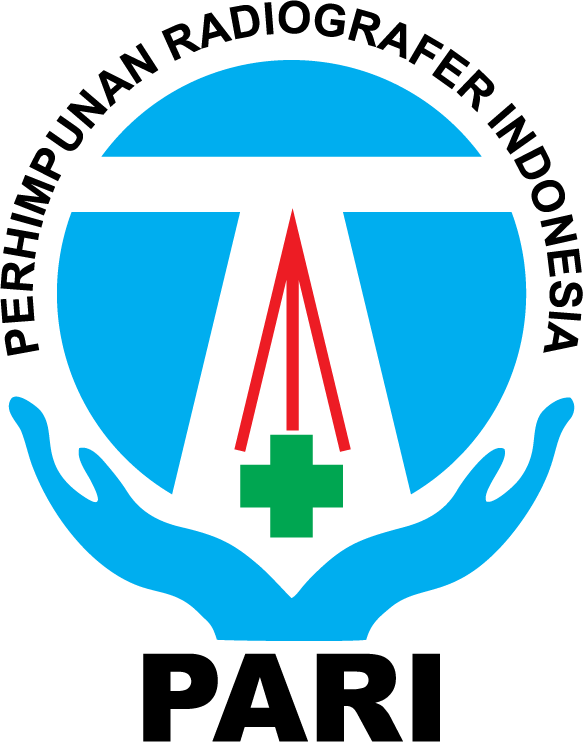Perbedaan Nilai Dosis Radiasi Permukaan Kulit Gonad pada Radiografi Abdomen Antero Posterior pada Nilai mA dan s Berbeda dengan Nilai mAs yang Sama
Abstract
Background: Abdominal radiography examination is one of the examinations that is often carried out and contains radiosensitive organs, namely the gonads. Milli Ampere Second (mAs) is one of the parameters regulated in making radiographs besides kV. mAs is the product of mA and s and there are often variations in the use of mA and s values to produce the same mAs value. This study's objective was to identify
the difference in radiation dose values for the surface of the gonad skin on anteroposterior abdominal radiographs with changes in different combinations of mA and s values.s
Methods: This is pre-experimental quantitative research. The research object is body phantom. Data were collected by exposing abdomen radiography the body phantom and measured the amount of radiation dose to the skin surface of the gonad. mA and s setting : 160 mA 125 ms; 200 mA 100 ms; dan 250 mA 80 ms. Data analysis was carried out using statistical tests.
Results: The average radiation dose to the skin surface of the gonad organs in the combination is 160 mA 125 ms; 200 mA 100 ms; and 250 mA 80 ms, namely 883.27 µGy; 883.09 µGy; and 883.72 µGy. Statistical test results show there is no significant difference between the combination of 160 mA 125 ms; 200 mA 100 ms; and 250 mA 80 ms, namely 883.27 µGy; 883.09 µGy with a significance of 0.748 (p-value > 0.05). mAs determine the intensity of X-rays; the number of X-rays produced is proportional to milliamperes. As long as the mAs value remains constant, the amount of radiation intensity produced is the same, and the radiation dose is same
Conclusions: There is no significant difference in the value of radiation dose to the skin surface of the gonad area on abdominal radiography with different combinations of mA and s values at the same mAs valueKeywords
Full Text:
PDFReferences
Agency, U. S. E. P. (2023). Radiation Health Effects. https://www.epa.gov/radiation/radiation-health-effects
Bequet, A. Y., & Isnoviasih, S. T. (2022). Perbandingan Nilai Index Exposure pada Radiografi Thorax dengan Perubahan Kombinasi Nilai mA dan s Berbeda pada Nilai mAs yang Sama. Jurnal Imejing Diagnostik, 8(2), 135–140. https://doi.org/http://dx.doi.org/10.31983/jimed.v8i2.9324
BKPK, H. (2022). Transformasi Kesehatan Sukseskan Tujuan Pembangunan Kualitas Hidup Masyarakat. Badan Kebijakan Pembangunan Kesehatan. https://www.badankebijakan.kemkes.go.id/transformasi-kesehatan-sukseskan-tujuan-pembangunan-kualitas-hidup-masyarakat/
Bontrager, K. L., & Lampignano, J. P. (2014). Textbook of Radiographic Positioning and Related Anatomy (8th ed.). Elsevier Mosby.
Bushong, S. C. (2013). Radiologic Science for Technologist: Physics, Biology and Protection (10th ed.). Elsevier Mosby.
Choudhary, S. (2018). Deterministic and Stochastic Effects of Radiation. Cancer Therapy & Oncology International Journal, 12(2). https://doi.org/10.19080/CTOIJ.2018.12.555834
Finn, A. Y., McKiddie, F., Prescott, S., & Griffiths, R. (2024). Farr’s Physics for Medical Imaging (3rd ed.). Elsevier Limited.
Indrati, R., Masrochah, S., Susanto, E., Kartikasari, Y., Wibowo, A. S., Darmini, Abimanyu, B., Rasyid, & Murniati, E. (2021). Proteksi Radiasi Bidang Radiodiagnostik dan Intervensional (II). Inti Medika Pustaka.
DOI: https://doi.org/10.31983/jimed.v1i1.12308
Article Metrics
Refbacks
- There are currently no refbacks.
JURNAL IMEJING DIAGNOSTIK by http://ejournal.poltekkes-smg.ac.id/ojs/index.php/jimed is licensed under a Creative Commons Attribution-ShareAlike 4.0 International License.

.png)
.png)
.png)
.png)
.png)
.png)
.png)












